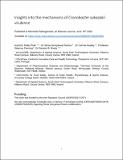| dc.contributor.author | Phair, Katie | |
| dc.contributor.author | Gonçalves Pereira, Sónia | |
| dc.contributor.author | Kealey, Carmel | |
| dc.contributor.author | Fanning, Séamus | |
| dc.contributor.author | Brady, Damien B. | |
| dc.date.accessioned | 2022-09-09T16:56:48Z | |
| dc.date.available | 2022-09-09T16:56:48Z | |
| dc.date.copyright | 2022-06 | |
| dc.date.issued | 2022-06 | |
| dc.identifier.citation | Katie Phair, Sónia Gonçalves Pereira, Carmel Kealey, Séamus Fanning, Damien B. Brady, Insights into the mechanisms of Cronobacter sakazakii virulence, Microbial Pathogenesis, Volume 169, 2022,105643 | en_US |
| dc.identifier.uri | http://research.thea.ie/handle/20.500.12065/4035 | |
| dc.description.abstract | Cronobacter species have adapted to survive harsh conditions, particularly in the food manufacture environment, and can cause life-threatening infections in susceptible hosts. These opportunistic pathogens employ a multitude of mechanisms to aid their virulence throughout three key stages: environmental persistence, infection strategy, and systemic persistence in the human host. Environmental persistence is aided by the formation of biofilms, development of subpopulations, and high tolerance to environmental stressors. Successful infection in the human host involves several mechanisms such as protein secretion, motility, quorum sensing, colonisation, and translocation. Survival inside the host is achieved via competitive acquisition and utilization of minerals and metabolites respectively, coupled with host immune system evasion and antimicrobial resistance (AMR) mechanisms. Across the globe, Cronobacter sakazakii is associated with often fatal systemic infections in populations including neonates, infants, the elderly and the immunocompromised. By providing insight into the mechanisms of virulence utilised by this pathogen across these three stages, this review identifies current gaps in the literature. Further research into these virulence mechanisms is required to inform novel mitigation measures to improve global food safety with regards to this food-borne pathogen. | en_US |
| dc.format | application/pdf | en_US |
| dc.language.iso | eng | en_US |
| dc.publisher | Elsevier | en_US |
| dc.rights | Attribution-NonCommercial-ShareAlike 4.0 International | * |
| dc.rights.uri | http://creativecommons.org/licenses/by-nc-sa/4.0/ | * |
| dc.subject | enviroCORE - IT Carlow | en_US |
| dc.subject | Pathogenesis | en_US |
| dc.subject | Virulence mechanisms | en_US |
| dc.subject | Environmental persistence | en_US |
| dc.title | Insights into the mechanisms of Cronobacter sakazakii virulence | en_US |
| dc.type | info:eu-repo/semantics/article | en_US |
| dc.contributor.affiliation | EnviroCORE, Department of Applied Science, South East Technological University, Carlow Campus, Kilkenny Road, County Carlow | en_US |
| dc.contributor.affiliation | ciTechCare, Centre for Innovative Care and Health Technology, Polytechnic of Leiria, 2411-541 Leiria, Portuga | en_US |
| dc.contributor.affiliation | Department of Pharmaceutical Sciences and Biotechnology, Technical University of the Shannon: Midlands Midwest, Athlone campus, Dublin Road, Kilmacuagh, Athlone, County Westmeath, N37 HD68, Ireland | en_US |
| dc.contributor.affiliation | UCD-Centre for Food Safety, School of Public Health, Physiotherapy & Sports Science, University College Dublin, Belfield, Dublin D04 N2E5, Ireland | en_US |
| dc.contributor.affiliation | enviroCORE, Department of Applied Science, South East Technological University, Kilkenny Road Campus, Kilkenny Road, County Carlow, R93 V960, Ireland | en_US |
| dc.contributor.sponsor | Irish Research Council | en_US |
| dc.description.peerreview | yes | en_US |
| dc.identifier.doi | https://doi.org/10.1016/j.micpath.2022.105643 | en_US |
| dc.identifier.orcid | 0000-0003-2815-4653 | en_US |
| dc.identifier.url | https://www.sciencedirect.com/science/article/abs/pii/S088240102200256X | en_US |
| dc.identifier.volume | 169 | en_US |
| dc.rights.accessrights | info:eu-repo/semantics/openAccess | en_US |
| dc.type.version | info:eu-repo/semantics/acceptedVersion | en_US |
| dc.audience | Researchers, students, public health | en_US |


